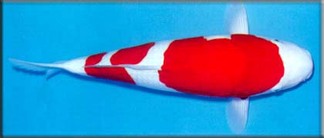
Modern-day Kohaku koi, known for their white-bodies and red patterns, have had a long history of cross-breeding that dates back to the the mid-1800’s. A manual on koi cultivation in the Niigita Prefecture of Japan relates the development of Sarasa (white carp with red markings on its head) by cross-breeding the Magoi (wild black carp) with Higoi (red carp) and Shirigoi (white carp). Others believe that these red and whites were products of cross-breeding red-headed Narumi Asagis (a breed of blue-netted koi) and Magoi’s. Whatever the case may be the Sarasa developed into the “Gosuke Sarasa ” in 1889 through the work of a breeder named Kunizou Hiroi also known as Utogi ni Gosuke (Utogi from the farm of Gosuke). It is from this Gosuke bloodline that all Kohaku koi have descended since.
Most of the criteria for discerning quality Kohaku koi comes from the characteristics of its “hi” (red markings). It is important that the “hi” should be uniform in color and have well-defined edges that do not bleed or fade into the white. It is crucial in all koi that the “hi” be well-formed and not contain bits of white within them. The “hi” should also be artistically distributed and should make-up half to two-thirds of the Kohaku koi’s color. Although body “hi” need not be symmetrical on a Kohaku, it should nonetheless be balanced, not being either top nor bottom-heavy.
“Hi” is also exhibited in “steps” or consecutive right-left-right red spots on a fish’s back. The more steps on a Kohaku’s body, the more prized it is. A two-stepped pattern is called “Nidan,” which is the Japanese word for second. Similarly, “Sandan,” “Shindan” and “Godan” are the words for “third,” “fourth” and “fifth” and are used to describe Kohaku koi exhibting three, four and (even better) five-stepped patterns. Sometimes, these hi markings do not occur as several separate spots but come in an “Ippon-hi” or large continuous red pattern. Interesting images are formed from these such as those of an “Inazuma” or lightning bolt of red running from head to tail or a “Straight Hi” which describes a continuous stroke that likewise runs lengthwise on the fish’s back.
“Hi” on the head is an essential element for all Kohaku. While the most valued of Kohaku koi’s should not have any red on their fins, below the eyes or in and around the mouth, Kuchibeni (red around the mouth like lipstick) or Menkaburi (red hood covering all of eyes and mouth) markings are still considered acceptable. Kutsubera (U-shaped just above the eyes) markings are considered exceptional. Other hi patterns also include the Maruten (red blotch on top of head) and the Tancho. This latter pattern occurs when there is a single red blotch on the center of a Kohaku’s white head. The rounder the mark the better, as it would look more like sun on the Japanese flag! These Tancho koi are technically judged in a separate class.
Keep in mind that “hi” must wrap around the fish’s body, preferably around the lateral lines from gills to tail. The “odome” (tail stop) which is a white barrier between hi on the tail and the “hi” on the main body of the Kohaku is a marker for balance with the fish’s white nose.
Ideally, the Kohaku’s white color should be as pristine as snow and not yellowing in any way so that it contrasts strikingly against the deep red markings of “hi.”
There are many more complexities in judging quality Kohaku koi and even more details in caring for tategoi (young koi) in order to breed prize-winners. This is perhaps attributed to the fact that Kohakus are the most popular koi varieties to-date. As such, they are not only standard-bearers of the colors of the Japanese flag but of the beauty of Japanese culture itself.

